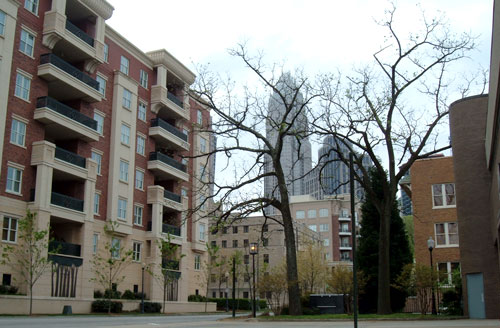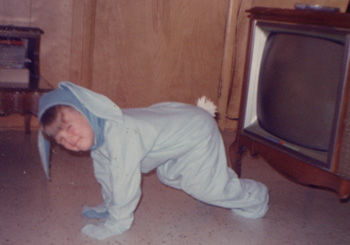
Of course, what I’m wondering is whether anyone got in trouble for allowing it to be shown on TV…
Seriously, who writes these headlines?
Where the intelligence is neither artificial nor abundant

Of course, what I’m wondering is whether anyone got in trouble for allowing it to be shown on TV…
Seriously, who writes these headlines?
It’s interesting that the San Francisco Chronicle is running a series on how certain “new urbanist” developments in the Bay Area are attempting to redefine suburbia in a more superficially urban context. I say “interesting” because San Francisco has spent the past few decades enthusiastically transforming itself into something of a cartoon-style parody of urbanism, suggesting that this new trend is by no means limited to Petaluma or San Mateo.
Nor is this tendency toward “urbanism” as a stage prop — let’s call it “urban lite” — limited to the Bay Area’s environs. Nearly every up and coming (or down and out) municipality in America seems to have succumbed in one way or another to the notion that lively and exciting urban spaces can be built from scratch using a shopping center mentality and some architecture straight out of Walt Disney’s sketchbook.
As laughable as “urban lite” may be in a suburban setting with wide open spaces connected only by freeways, it’s downright tragic when practiced in an actual urban area, where creating the aesthetic invariably involves bulldozing large spaces that may actually have been urban in character in order to replace them with huge monstrosities that are the absolute antithesis of “urban”.
My occasional hometown of Charlotte has been very susceptible to this mentality, egged on by the “make no small plans” boosterism of columnist Doug Smith, the repeated broadcast news references to “Center City” (a mythical neighborhood no actual Charlottean seems ever to have visited or mentioned in conversation), and the often comical postings on Urban Planet, a forum run by a pompous blowhard of questionable intellect from suburban Huntersville, perhaps the least urban place — other than “Center City” — to be found within fifty miles of Charlotte (ask me about the run-in we had once). The prevailing opinion seems to be that “urban” is a catchy synonym for “shiny new chain stores in really big buildings”. As long as they’re “world class” and don’t have visible parking lots, that is…
On first glance (and second, and third) Charlotte seems to be one of the most antiseptic places on earth, founded on the notion that all spaces are created equal and that value is only added by making them as bland and comforting to middle class white people as possible. It’s sad how much of the city has been lost; in Charlotte, urban renewal was just the beginning of the carnage. It’s very disorienting to find yourself downtown in a city of 600,000 people and to realize suddenly that there’s nothing for blocks and blocks that was built before 1985. There are no old department stores, no old hotels, and no old commercial blocks — nothing at all but shiny new skyscrapers whose footprints cover entire city blocks. Possessing all the spontaneous charm of an airport office park with an adjacent TGI Friday’s, downtown Charlotte is anything but urban in character.

— In this case, density ≠ vitality.
And the cancer is spreading to “historic” areas that surround the central city as well. The few streetcar strips and older commercial areas along South Boulevard and Elizabeth Avenue, where a lively urban feel might have developed, are being largely replaced by mammoth complexes of first floor chain stores (or empty shells where no chain stores have yet ventured) and overpriced condos above. The assumption is that the “creative class” will flock to the inner city as long as it’s been completely transformed into a very dense and compact version of the very suburbs these “edgy” souls are presumably trying to escape. It doesn’t require much imagination to realize what these developments will be like a decade or so down the road.
“Urban” is not by any means synonymous with “old” or “never changing”. In earlier times, buildings were sometimes remodeled and reused, and sometimes torn down and replaced. But it was all done on a small scale, building by building, and the occasional mistake was easily overlooked and replaced. This is no longer the case. It’s hard to overlook a tremendous project that covers six city blocks and costs $50 million; it’s pretty much there for the long haul and can only be replaced by another similarly massive project, which will probably also be a mistake. There are lots of these mistakes sprouting in Charlotte and dozens of other American cities nowadays.
It’s sad, really. Charlotte can be an interesting place. If you’re willing to do a little digging, you really can find some texture and variety there. You’ll also have to do a fair amount of driving; the texture and variety are very dispersed, due to the repeated destruction of their natural habitats. There’s still a restaurant here and a cluster of storefronts there that haven’t been completely sanitized. But I don’t hold much hope that they’ll be there very long.
Call me a segregationist if you must, but I prefer that my urban settings remain urban and that my suburbs remain suburban. I don’t think there’s anything inherently wrong with either of them, but I also don’t think they’re interchangeable with respect to design or appeal.
Charlotte was nicer back when it was still a city. So was San Francisco.
Every once in a while I have a vaguely surreal experience that reminds me how much different my current home is from the one I occupied two years ago. And one happened today, as I was driving down Hanes Mall Boulevard, the local retail strip. Just north of Target, the entire busy six-lane thoroughfare came to a screeching halt, as all traffic in both directions waited for a goose (or a duck?) and her assorted offspring to cross the street.
This didn’t happen very often South of Market, even on Easter Sunday.
Speaking of Easter, one of the coolest things about living in Winston-Salem is that Mitch Easter lives here too, which means I get to see him live at The Garage next month.

